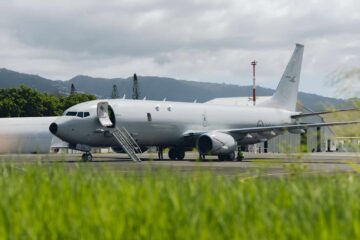“This order provides for the design, development, and test of software and ancillary hardware necessary for the integration of the Long Range Anti-Ship Missile onto the P-8A aircraft for the Navy,” the US DoD announced on April 21.
Work will be performed in Seattle, the home of Boeing, and is expected to be completed in October 2024. The Naval Air Systems Command (NAVAIR) is the contracting activity.
Naval News first reported about LRSAM integration on the P-8A in November 2019 when Lockheed Martin representatives told us that fit checks of the next gen anti-ship missile with the Poseidon maritime patrol aircraft were conducted in 2018.
In February 2020, a first contract notice confirmed a project of aeromechanical and software integration of the LRASM missile onto the P-8A aircraft. “LRASM is a mature system which will be integrated into the P-8A TOMS [Tactical Open Mission Systems] and SMC [Stores Management Computer] software,” the contract opportunity read at the time.
This effort, which will run from January 2021 through January 2026, should also include 500 to 2,000 lb class of Joint Direct Attack Munition (JDAM) variants, Mk62/63/65 mines, Small Diameter Bomb (SDB-II), Miniature Air Launched Decoy (MALD), Bomb Rack Unit BRU-55, and Universal Armament Interface (UAI). U.S. Navy’s P-8A Poseidon currently deploy AGM-84D Block 1C Harpoon anti-ship missiles for their anti-surface warfare missions. Incremental future upgrades include the AGM-84 Harpoon II+ variant which brings GPS and a data link that allows the shooter to change the missile’s target in flight. The venerable (and world famous) Harpoon will have to be replaced, eventually, at some point in the future, as is already the case on surface ships (with the Naval Strike Missile selected by the U.S. Navy for new programs such as the LCS and FFG(X)).
About AGM-158C LRASM anti-ship missile

LRASM is designed to detect and destroy specific targets within groups of ships by employing advanced technologies that reduce dependence on intelligence, surveillance and reconnaissance platforms, network links and GPS navigation in electronic warfare environments. LRASM will play a significant role in ensuring military access to operate in open ocean/blue waters, owing to its enhanced ability to discriminate and conduct tactical engagements from extended ranges.
BAE Systems’ long-range sensor and targeting technology enables LRASM to detect and engage protected ships in all weather conditions, day or night, without relying on external intelligence and navigation data.
The advanced LRASM sensor technology builds on BAE Systems’ expertise in electronic warfare (EW), signal processing, and targeting technologies, and demonstrates the company’s ability to apply its world-class EW technology to small platforms.
Armed with a 1,000 Lbs (454 kg) penetrating blast fragmentation warhead, LRASM is low observable and likely has a range comparable with JASSM ER (around 500 nautical miles).
LRASM is designed to meet the needs of U.S. Navy and U.S. Air Force Warfighters in contested environments. The air-launched variant provides an early operational capability for the U.S. Navy’s offensive anti-surface warfare Increment I requirement.
LRASM Achieved EOC with the U.S. Navy’s F/A-18E/F Super Hornet in December 2019 and may soon find its way aboard the B-52 bomber of the U.S. Air Force.






